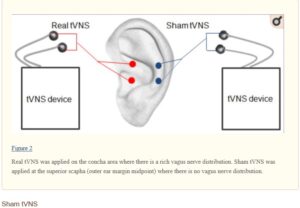Analysis of taVNS effects on autonomic and central nervous systems in healthy young adults based on HRV, EEG parameters
Kristen Sparrow • July 13, 2024

 As readers know, I’ve been using TAVNS, transcutaneous vagal nerve stimulation, (vagal stimulation of the ear) in the clinic for years, looking at its effects in conjunction with acupuncture as a function of HRV. Some of the discussion here, here and here. In the clinic the vast majority of patients enjoy the TAVNS.
As readers know, I’ve been using TAVNS, transcutaneous vagal nerve stimulation, (vagal stimulation of the ear) in the clinic for years, looking at its effects in conjunction with acupuncture as a function of HRV. Some of the discussion here, here and here. In the clinic the vast majority of patients enjoy the TAVNS.
In this study they looked at TAVNS in healthy young adults in their 20’s. There were only 10, but nonetheless they saw marked increase in HRV, a sign of improved autonomic balance. They also saw changes in EEG, though they didn’t specify. Interestingly, they say that the change was indicative of “responders”. That leads me to think that not everyone responded. Interesting since that was the premise of my very first paper.
Abstract
Objective.Transcutaneous auricular vagus nerve stimulation (taVNS), a non-invasive method of stimulating the vagus nerve, simultaneously affects the autonomic nervous system (ANS) and central nervous system (CNS) through efferent and afferent pathways. The purpose of this study is to analyze the effect of taVNS on the ANS and CNS through heart rate variability (HRV) and electroencephalography (EEG) parameters of identified responders.Approach.Two sets of data were collected from each of 10 healthy adult male subjects in their 20 s, and five HRV parameters from the time domain (RMSSD, pNN50, pNN30, pNN20, ppNNx) and two EEG parameters (power of alpha band, power of delta band) were extracted.Main results.Based on pNN50, responders to taVNS were identified; among them, pNN50 (p= 0.0041) and ppNNx (p= 0.0037) showed significant differences before and after taVNS. At the same time, for alpha power and delta power of EEG, significant difference (p< 0.05) was observed in most channels after taVNS compared to before stimulation.Significance.This study demonstrated the validity of identifying responders using pNN50 and the influence of taVNS on both the ANS and CNS. We conclude that taVNS can be used to treat a variety of diseases and as a tool to help control the ANS and CNS.
Keywords: electroencephalography; healthy young adults; heart rate variability; responder; transcutaneous auricular vague nerve stimulation.

